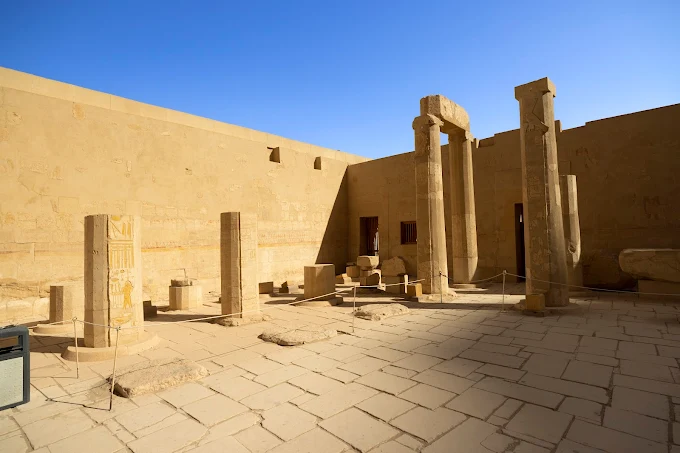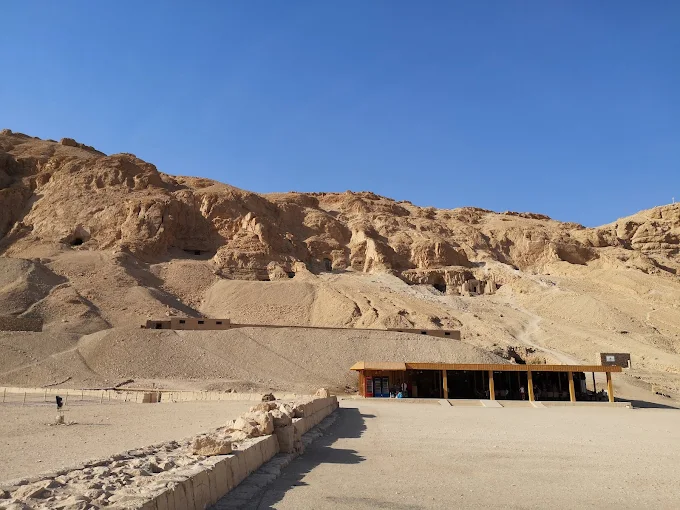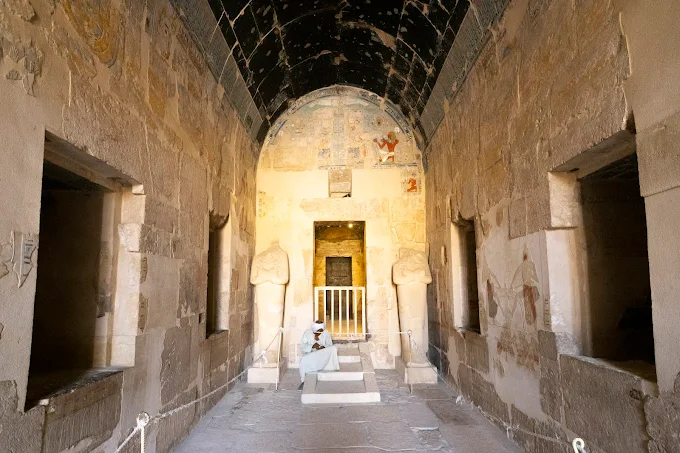Hatshepsut Temple from Hurghada
If you’re visiting Egypt’s Red Sea coast and want to immerse yourself in the wonders of ancient history, a trip to the Hatshepsut Temple from Hurghada is an unmissable experience. This extraordinary journey takes you from the turquoise waters and sandy beaches of Hurghada to the heart of Luxor’s West Bank, where the breathtaking Hatshepsut Temple—also known as the Mortuary Temple of Hatshepsut—stands as one of the most iconic monuments of the ancient world.
A visit to the Hatshepsut Temple from Hurghada is more than just a sightseeing tour—it’s a time-travel experience that transports you nearly 3,500 years into Egypt’s New Kingdom era. Standing before its grand terraces and dramatic cliffs, you’ll feel the same awe the ancient Egyptians must have felt as they approached this sacred site dedicated to one of the most remarkable female pharaohs in history.
Introduction to the Hatshepsut Temple from Hurghada
The journey from Hurghada to Luxor spans roughly 4 to 5 hours by road, but every moment is worth it when your destination is the Hatshepsut Temple. Nestled at the base of towering limestone cliffs in Deir el-Bahari, this masterpiece of ancient architecture honors Queen Hatshepsut—Egypt’s legendary female ruler who reigned during the Eighteenth Dynasty.
When you book a Hatshepsut Temple from Hurghada tour, you’re not just visiting a single site; you’re stepping into a complex of history, art, and spiritual symbolism. The temple’s design, carved partially into the rock face, is unlike anything else from ancient Egypt. It reflects both power and elegance, blending harmoniously with its natural surroundings while showcasing the ambition of a ruler who defied tradition to become pharaoh.
The Remarkable Story Behind the Hatshepsut Temple from Hurghada
Before setting out on your Hatshepsut Temple from Hurghada adventure, it’s worth learning about the incredible woman who commissioned this temple. Hatshepsut was the daughter of Thutmose I and the principal wife of Thutmose II. After her husband’s death, she acted as regent for her young stepson, Thutmose III, but soon took the unprecedented step of declaring herself Pharaoh.
Her reign, lasting over two decades, was marked by peace, prosperity, and monumental building projects—including the temple that now bears her name. The Hatshepsut Temple from Hurghada experience offers a rare glimpse into a period when a woman ruled as king, complete with the royal beard and regalia usually reserved for male pharaohs.
Architectural Brilliance of the Hatshepsut Temple from Hurghada
The Hatshepsut Temple from Hurghada journey will lead you to one of the most impressive structures in all of ancient Egypt. Designed by Hatshepsut’s royal architect and trusted advisor, Senenmut, the temple is laid out in three massive terraces connected by long ramps. Each level is adorned with colonnades—rows of elegant columns—and intricate reliefs depicting scenes from Hatshepsut’s reign.
Unlike other temples of the period, the Hatshepsut Temple seems to grow organically from the cliffs behind it. This integration of architecture and natural landscape is one reason UNESCO recognizes it as a masterpiece of human creative genius. Visitors on a Hatshepsut Temple from Hurghada tour are often struck by the temple’s symmetry, grandeur, and the way it changes in color and shadow throughout the day as the desert sun moves across the sky.

Why a Hatshepsut Temple from Hurghada Tour is Unforgettable
Historical Depth – Standing on the terraces, you’ll see detailed carvings of Hatshepsut’s expedition to the Land of Punt—a prosperous trading mission that brought exotic goods like incense, ebony, and myrrh trees to Egypt.
Breathtaking Setting – The temple is framed by a dramatic desert backdrop, with sheer cliffs rising directly behind it.
Cultural Insight – A Hatshepsut Temple from Hurghada trip often includes visits to other West Bank treasures such as the Valley of the Kings, making it a rich cultural journey.
Photographic Beauty – The sharp lines of the temple against the rugged cliffs create some of the most stunning travel photos you’ll take in Egypt.
The Full Itinerary of a Hatshepsut Temple from Hurghada Tour
A Hatshepsut Temple from Hurghada trip is not just a straight line from the Red Sea to Luxor—it’s a full-day adventure through Egypt’s diverse landscapes and deep history. Most organized tours follow a carefully planned itinerary to make sure you get the most out of your journey.
Early Morning Departure
The day begins before sunrise, with hotel pickup around 4:00 AM (sometimes earlier for group tours). As your vehicle leaves Hurghada’s vibrant coastline behind, you’ll travel through stretches of desert where the morning light paints the mountains in shades of gold and rose. This early start is essential for making the most of your time at the Hatshepsut Temple from Hurghada and other Luxor highlights.
Arrival in Luxor – Gateway to Ancient Thebes
By mid-morning, you’ll arrive in Luxor, once known as Thebes, the capital of ancient Egypt. Your first stop is often on the West Bank of the Nile, where the Hatshepsut Temple proudly stands. Some itineraries begin with a quick photo stop at the Colossi of Memnon—two massive stone statues guarding the ancient mortuary temple of Amenhotep III—before heading toward Deir el-Bahari.
Exploring the Hatshepsut Temple
This is the heart of the tour. Upon arrival, you’ll walk through a vast forecourt leading up to the first terrace. As you ascend each level, your guide will explain the significance of the reliefs, statues, and architectural choices. You’ll see scenes of divine birth, trade expeditions, and offerings to the gods—all carved in remarkable detail.
The Hatshepsut Temple from Hurghada tour usually gives you at least 1–1.5 hours on-site, enough to explore each terrace and take in the breathtaking views of the cliffs and desert beyond.
Additional West Bank Sites
After visiting the Hatshepsut Temple, most tours include other West Bank sites such as:
Valley of the Kings – The burial place of pharaohs like Tutankhamun and Ramses II.
Medinet Habu – The mortuary temple of Ramses III, known for its colorful wall reliefs.
Lunch Break
Tours typically stop for a buffet lunch in Luxor, offering a mix of Egyptian and international dishes.
East Bank Excursions
If your Hatshepsut Temple from Hurghada package includes the East Bank, you’ll visit:
Karnak Temple Complex – One of the largest religious complexes ever built.
Luxor Temple – A stunning temple illuminated beautifully if visited in the late afternoon or evening.
Return to Hurghada
After a full day of exploring ancient wonders, you’ll begin the journey back to Hurghada, arriving in the evening with unforgettable memories of your time at the Hatshepsut Temple from Hurghada.

What to See Inside the Hatshepsut Temple from Hurghada Tour
The temple is a treasure trove of history and art, and each terrace offers something unique:
First Terrace – The Foundation of Grandeur
Here you’ll find the colonnade with scenes of the divine birth of Hatshepsut and the coronation ceremony that legitimized her reign. The walls also display her dedication to the god Amun-Ra, reflecting the deep religious significance of the site.
Second Terrace – The Land of Punt Expedition
This level contains one of the most famous sets of reliefs in all of Egypt: the depiction of Hatshepsut’s trading expedition to the Land of Punt. These carvings provide valuable insight into ancient trade, maritime navigation, and Egypt’s connections with distant lands.
Third Terrace – Sanctuaries and Chapels
The uppermost level includes the Sanctuary of Amun, the Chapel of Hathor, and the Chapel of Anubis. Each space is intricately decorated with religious iconography and inscriptions that tell stories of worship and divine favor.
A Hatshepsut Temple from Hurghada tour allows you to see these areas up close, appreciating the blend of architectural mastery and symbolic meaning.
Travel Tips for Your Hatshepsut Temple from Hurghada Experience
Wear Comfortable Clothing – The desert climate can be hot, even in winter. Lightweight, breathable fabrics are best.
Bring Sun Protection – A hat, sunglasses, and sunscreen are essential for exploring the open terraces.
Stay Hydrated – Carry bottled water, especially during the hotter months.
Use a Local Guide – Their knowledge brings the temple’s reliefs and history to life in a way guidebooks cannot.
Book Early – High season (October to April) can get busy, so secure your Hatshepsut Temple from Hurghada tour in advance.
The Life and Legacy of Queen Hatshepsut
No visit to the Hatshepsut Temple from Hurghada is complete without understanding the remarkable woman behind its creation—Queen Hatshepsut, one of ancient Egypt’s most influential and visionary rulers. She was not only a pharaoh but also a skilled politician, diplomat, and builder whose reign left an enduring mark on Egyptian history.
From Royal Daughter to Pharaoh
Hatshepsut was born into the royal family during Egypt’s prosperous 18th Dynasty, the daughter of Pharaoh Thutmose I and his principal wife, Ahmose. From a young age, she was immersed in the rituals, politics, and responsibilities of Egyptian royalty. Initially serving as queen consort to her half-brother Thutmose II, she later took the unprecedented step of declaring herself pharaoh—a position almost exclusively held by men.
Her rise to power was not sudden. Acting first as regent for her young stepson, Thutmose III, she gradually consolidated authority, eventually adopting full royal regalia and the title of Pharaoh of Upper and Lower Egypt. This bold move allowed her to embark on ambitious projects, including the grand construction of her mortuary temple at Deir el-Bahari—what we now know as the Hatshepsut Temple.
A Visionary Ruler and Skilled Diplomat
Hatshepsut’s reign was marked by peace, prosperity, and cultural expansion. Instead of focusing solely on military conquests, she invested heavily in trade and infrastructure. Her famous expedition to the Land of Punt, immortalized in detailed reliefs at the Hatshepsut Temple, brought back exotic goods such as myrrh trees, incense, ivory, and gold.
When you embark on a Hatshepsut Temple from Hurghada tour, these reliefs are among the highlights. They offer a vivid, almost cinematic depiction of this journey—complete with depictions of Punt’s people, their architecture, and the rich bounty brought back to Egypt.
Architectural Ambition
Hatshepsut’s vision extended beyond politics and trade. She was a patron of monumental architecture, commissioning temples, obelisks, and sanctuaries across Egypt. Her crowning achievement remains the Hatshepsut Temple, designed in harmony with the cliffs of Deir el-Bahari. This design not only showcased her divine authority but also blended seamlessly with the natural environment—a rare feat in ancient architecture.
For modern travelers, a Hatshepsut Temple from Hurghada trip is more than sightseeing; it’s a chance to stand in a place built by one of history’s few female rulers, to witness how her ambition and artistry came together in stone.
A Contested Legacy
After her death, her successor Thutmose III attempted to erase her memory from history, chiseling away her images and cartouches. While some historians believe this was an act of vengeance, others argue it was a political move to restore traditional male rule. Regardless, enough survived for archaeologists to reconstruct her story and preserve her achievements for future generations.
When you visit the Hatshepsut Temple from Hurghada, you’ll see areas where the original inscriptions were damaged and later restored—powerful reminders of how fragile historical memory can be.

The Construction of Hatshepsut Temple
For anyone taking the Hatshepsut Temple from Hurghada journey, one of the most fascinating aspects to learn about is the story behind its construction. The temple, officially known as Djeser-Djeseru (“The Holy of Holies”), stands as a testament to ancient Egyptian engineering, artistry, and religious devotion. Its design, location, and purpose were the result of a carefully orchestrated vision by Queen Hatshepsut and her trusted architect, Senenmut.
The Role of Senenmut – The Mastermind Behind the Design
Senenmut, a highly educated and talented official, served as Hatshepsut’s chief architect, advisor, and possibly confidant. His design for the Hatshepsut Temple was unlike anything Egypt had seen before. Rather than following the traditional horizontal layout of most temples, Senenmut incorporated three monumental terraces that seemed to rise naturally from the base of the Theban cliffs.
When you take a Hatshepsut Temple from Hurghada tour, one of the first things you’ll notice is how perfectly the structure aligns with the limestone cliffs behind it. This integration was intentional, symbolizing the temple’s harmony with nature and the divine.
Timeline and Construction Techniques
Construction began during the early years of Hatshepsut’s reign and continued for more than 15 years. Ancient builders used local limestone, hauling massive blocks from nearby quarries. Wooden ramps, levers, and copper tools were employed to shape and position the stone—a labor-intensive process requiring thousands of skilled workers and craftsmen.
Despite the absence of modern machinery, the precision of the stone cutting and alignment is extraordinary. Visitors on a Hatshepsut Temple from Hurghada excursion can still see evidence of the careful craftsmanship in the perfectly straight colonnades and detailed relief carvings.
Religious and Symbolic Layout
The temple’s three terraces were connected by long ramps and lined with colonnades. Each level served a distinct purpose:
First Terrace: Functioned as the grand entrance, with gardens and pools that have long since vanished.
Second Terrace: Contained chapels and reliefs depicting significant events, such as the divine birth of Hatshepsut and the expedition to Punt.
Third Terrace: Housed the sanctuary dedicated to Amun-Ra, the chief deity of Thebes.
For travelers arriving on a Hatshepsut Temple from Hurghada day trip, exploring these levels is like walking through chapters of an ancient story, each terrace revealing a deeper layer of spiritual and political meaning.
Integration with the Theban Necropolis
The Hatshepsut Temple is part of the larger Theban Necropolis, a sprawling complex of tombs and temples that includes the Valley of the Kings and the Valley of the Queens. Its placement at Deir el-Bahari—near the mortuary temple of Mentuhotep II—was no accident. By situating her temple here, Hatshepsut connected her legacy with Egypt’s Middle Kingdom and reinforced her divine legitimacy.
A modern Hatshepsut Temple from Hurghada itinerary often includes visits to these surrounding monuments, making the trip a full immersion into the ancient world.

Architectural Wonders of Hatshepsut Temple
The Hatshepsut Temple from Hurghada tour isn’t just a journey through time—it’s a lesson in ancient architectural brilliance. Even for travelers who have explored other temples in Egypt, the design of Hatshepsut’s mortuary temple stands apart for its symmetry, innovation, and harmony with the surrounding landscape.
Three-Tiered Terraces – A Monumental Innovation
The most striking feature of the Hatshepsut Temple is its three-level terrace design. This tiered approach was a bold departure from traditional Egyptian temples, which were typically built on a single horizontal plane. Each terrace rises majestically from the desert floor, connected by long central ramps that guide visitors toward the sanctuary.
When you arrive on a Hatshepsut Temple from Hurghada day trip, the sheer size and scale of these terraces are the first things that capture your attention. The lower terrace, once surrounded by lush gardens and pools, would have been a vision of life and fertility in contrast to the arid desert surroundings.
Colonnades and Pillars – Symmetry in Stone
Each terrace is framed by colonnades—rows of elegant square pillars or rounded columns. These not only provided structural support but also created shaded walkways where priests, officials, and visitors could process during religious ceremonies. The colonnades’ repetitive design draws the eye upward, emphasizing the temple’s vertical progression.
For photography enthusiasts on a Hatshepsut Temple from Hurghada excursion, the colonnades offer perfect framing for dramatic shots, especially in the golden light of early morning.
Reliefs and Inscriptions – Stories in Stone
The walls of the temple are covered in detailed reliefs that tell stories of Hatshepsut’s reign, divine ancestry, and religious devotion. Particularly famous are the reliefs of the expedition to the Land of Punt, showing exotic animals, ships, and goods that enriched Egypt’s wealth and culture.
Walking along these walls during a Hatshepsut Temple from Hurghada visit, you can trace the chisel marks left by ancient artisans over 3,000 years ago—a direct connection to the craftsmen who immortalized these stories.
Alignment with the Sun and Stars
The temple’s orientation was carefully calculated to align with the winter solstice sunrise. On this day, sunlight would travel directly through the central axis of the temple, illuminating the sanctuary dedicated to Amun-Ra. This celestial alignment reinforced the pharaoh’s divine relationship with the gods.
Many travelers taking a Hatshepsut Temple from Hurghada private tour aim to arrive early in the day to experience the play of light and shadow that has been a part of this temple’s beauty for millennia.
Harmony with the Cliffs of Deir el-Bahari
Perhaps the most remarkable architectural decision was to build the temple directly against the towering limestone cliffs. The natural rock face serves as a dramatic backdrop, making the temple appear as though it is an extension of the mountain itself. This seamless integration of man-made and natural elements is rare even in modern architecture.
Standing on the upper terrace during your Hatshepsut Temple from Hurghada trip, you can gaze out over the Nile Valley to the east and the desert cliffs to the west, just as ancient priests and royalty once did.
Religious Significance of Hatshepsut Temple
When embarking on a Hatshepsut Temple from Hurghada tour, you’re not just visiting an ancient structure—you’re stepping into a sacred space designed to bridge the world of humans and the divine. Every element of the temple’s design, decoration, and placement had profound religious meaning.
A Temple for the Afterlife
The Hatshepsut Temple, officially known as the Mortuary Temple of Hatshepsut, was built as a place where rituals would be performed to honor the queen after her death and ensure her safe passage into the afterlife. Ancient Egyptians believed that a ruler’s soul could continue to receive offerings and prayers if their mortuary temple remained active.
During a Hatshepsut Temple from Hurghada day trip, guides often explain how priests worked here daily, offering food, incense, and hymns to sustain Hatshepsut’s spirit in eternity.
Dedicated to Amun-Ra and Other Deities
While the temple served to glorify Hatshepsut, it was primarily dedicated to Amun-Ra, the chief god of Thebes. The inner sanctuary, aligned perfectly with the sun during the winter solstice, was the focal point for his worship.
Other gods and goddesses honored here include Hathor, the goddess of music, joy, and motherhood, and Anubis, the god of mummification. Each deity had its own chapel within the temple complex, and the walls are adorned with images and inscriptions celebrating their power.
On a Hatshepsut Temple from Hurghada excursion, the Chapel of Hathor is often a highlight, with its graceful columns topped by the goddess’s face and ears of a cow, symbolizing her nurturing and protective nature.
The Divine Birth Narrative
One of the most important religious messages carved into the temple’s walls is the story of Hatshepsut’s divine birth. According to the inscriptions, the god Amun took the form of Hatshepsut’s father and visited her mother, Queen Ahmose. This narrative legitimized her reign by portraying her not as a mere mortal, but as a child of the gods themselves.
Travelers on a Hatshepsut Temple from Hurghada tour can see these reliefs up close, with scenes showing the gods blessing the young Hatshepsut and foretelling her destiny as pharaoh.
The Journey to the Land of Punt – A Sacred Expedition
Perhaps the most famous reliefs in the temple depict Hatshepsut’s expedition to the Land of Punt, an event with both economic and religious significance. Punt was considered a mystical and sacred land, rich in incense, gold, ebony, and exotic animals—offerings fit for the gods.
The return of the Punt expedition was celebrated with great rituals, and the goods brought back were dedicated to Amun-Ra. On a Hatshepsut Temple from Hurghada guided tour, you can follow the story from departure to triumphant return, carved in exquisite detail across the temple walls.
Symbolism in Design
The temple’s vertical progression—from the earthly gardens on the first terrace to the divine sanctuary on the third—symbolizes the spiritual journey from the mortal realm to the realm of the gods. Every step upward was a step closer to the divine presence.
Visitors taking the Hatshepsut Temple from Hurghada route often remark on the sense of calm and reverence that builds as they ascend, mirroring the ancient worshippers’ own experience.
To be Continue your Egyptian adventure with a visit to the magnificent Hatshepsut Temple! Marvel at this ancient architectural wonder nestled against towering cliffs in Luxor. Explore the terraced colonnades, hieroglyphic reliefs, and sacred chambers of Egypt’s most famous female pharaoh’s mortuary temple. A must-see landmark on any Nile Valley tour.




